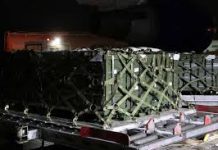
EU Strengthens Defence Strategy Amid Growing Security Concerns
The European Union has introduced a new initiative aimed at bolstering its defence capabilities, with the objective of deterring potential threats by 2030. This decision comes as tensions rise due to Russia’s ongoing military aggression and evolving global security dynamics. The European Commission has emphasized that Russia will continue to pose a “fundamental threat to Europe’s security for the foreseeable future.”
EU foreign policy chief Kaja Kallas highlighted the severity of the situation, stating, “We are not in a cold war, but rather facing an active conflict on European soil. The threat is as real as it gets.”
Major Defence Investment Plans in Motion
To support military procurement, the EU has proposed a €150 billion (£125 billion) loan scheme with strict conditions attached. In an effort to strengthen the European defence sector, 65% of the funds must be allocated to suppliers from the EU, Norway, or Ukraine. The remaining portion can be used for non-EU suppliers, provided they have a security agreement with the bloc.
This “Buy European” strategy is viewed as a win for France, but some nations, such as the Netherlands and Poland, have voiced concerns over its restrictive nature.
A senior EU diplomat cautioned against excluding trusted partners like the UK, stating, “The British defence industry is deeply integrated with ours. The West operates within an interconnected military supply chain, and cutting it off would not be practical.”
Shifting Alliances and Geopolitical Challenges
The EU’s decision to exclude the UK, US, and Turkey from funding unless they sign a security and defence partnership may create diplomatic complications. Despite the UK being acknowledged as a crucial European ally, a formal agreement is yet to be established. Kallas, after meeting with UK Foreign Secretary David Lammy, expressed optimism about potential progress in an upcoming EU-UK summit in May.
Concerns about NATO’s strength have also played a role in shaping these decisions. Danish intelligence recently warned that if NATO is perceived as weak, Russia could launch a large-scale war in Europe within five years. Danish Prime Minister Mette Frederiksen has called on EU leaders to set a firm deadline of 2030 for military rearmament.
European Commission President Ursula von der Leyen reinforced the urgency of the situation, stating that “readiness 2030” involves rearming, enhancing deterrence capabilities, and developing a robust defence industry.
Financial and Political Obstacles
Beyond security considerations, financial and political disagreements persist. The EU aims to generate €800 billion for defence efforts, combining €150 billion from EU-backed loans with €650 billion in fiscal flexibility, allowing member states to borrow for military spending without violating EU fiscal rules.
However, achieving this goal remains challenging. Wealthier nations such as Germany and the Netherlands are hesitant to take on EU-backed loans, while southern European countries are wary of further increasing their national debt.
Former Italian Prime Minister Mario Draghi has warned that European security is uncertain due to shifting US foreign policy, particularly concerns over former President Donald Trump’s stance on Russia. Meanwhile, a senior German official clarified, “We do not wish to give the impression that we are attempting to distance ourselves from the US.”
A Centralized Role in Defence Procurement?
The European Commission has proposed acting as a central defence procurement entity, potentially purchasing military equipment such as drones and missiles on behalf of member states. This approach mirrors previous EU-led efforts, such as vaccine procurement during the COVID-19 pandemic and the acquisition of ammunition for Ukraine.
EU Defence Commissioner Andrius Kubilius stressed the need for Europe to take control of its own security, arguing that the continent’s 450 million citizens should not have to rely on 340 million Americans for defence against 140 million Russians. “We are capable of doing better. It is time for us to take responsibility for Europe’s security,” he asserted.
Push for Greater Defence Funding
The European Parliament is advocating for a larger long-term defence industry initiative, arguing that the existing European Defence Industry Programme (EDIP) is inadequate. Lawmakers propose supplementing the initiative with an additional €15 billion from the Security Action for Europe (SAFE) loans for joint arms purchases, as well as an extra €5 billion to support Ukraine’s defence sector.
To qualify for funding, defence companies must have operations in at least five EU countries, Norway, or Ukraine. However, to prevent non-EU firms from dominating the market, any involvement from Norwegian or Ukrainian companies must be balanced with additional participation from EU-based manufacturers.
Debates continue over prioritizing European-made weaponry. While an agreement has been reached on a 65% European-sourced requirement for subsidized defence production, the European Parliament is pushing for this figure to be raised to 80%. Additionally, it is advocating for restrictions on sourcing components from “third countries that undermine the security and defence interests of the EU or its member states.”
Europe at a Crossroads in Defence Strategy
The EU’s ambitions to enhance its defence capabilities are met with both urgency and internal divisions. While the need for increased military preparedness is widely acknowledged, disagreements persist over funding mechanisms, industry protections, and diplomatic relations with key allies such as the UK and the US. The coming months will be crucial in determining whether European leaders can bridge these differences to achieve “readiness 2030” and establish a self-reliant defence force in an increasingly volatile global landscape.




